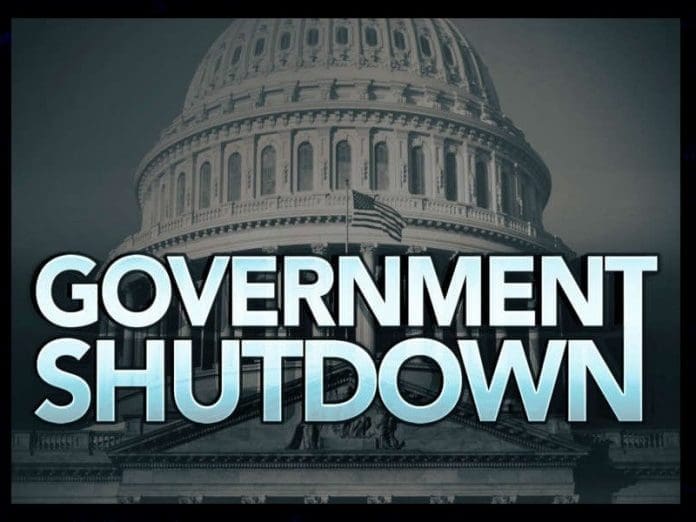The United States federal government shutdown reached its 22nd day on Wednesday, making it the second longest in American history as political leaders remain locked in a bitter standoff over healthcare subsidies and funding.
Since October 1, Senate Democrats have repeatedly blocked Republican attempts to reopen the government, with the impasse centered on demands to extend enhanced pandemic health insurance subsidies affecting approximately 22 million Americans who purchased policies through Affordable Care Act exchanges.
At a White House lunch with GOP senators on Tuesday, President Trump stood firm in his demands that Democrats vote to end the shutdown. Speaking at the gathering, Trump likened the Democratic stance to an extortion attempt, insisting they must “vote for the clean bipartisan continuing resolution and reopen our government, it’s got to be reopened right now.”
Senate Minority Leader Chuck Schumer has urged negotiations with the president, calling the situation the “Trump shutdown” and pressing for discussions on what he characterizes as a healthcare crisis. He told reporters his caucus would meet “any time, any place” before Trump’s scheduled travel.
However, House Speaker Mike Johnson maintains no high level meeting will occur until Democrats agree to reopen the government first. Writing on X, Johnson relayed that Trump “confirmed he is ready and willing for the three of us to meet with Leader Jeffries and Senator Schumer as soon as Schumer reopens the government.”
Senate Majority Leader John Thune echoed this position, telling reporters, “I don’t know what there is to negotiate. Open up the government first.” Thune indicated his strategy involves continuing to call votes on the proposed seven week stopgap funding bill, despite consistent Democratic opposition, believing lawmakers will “eventually come around.”
The White House has countered Democratic demands by noting the enhanced healthcare subsidies don’t expire until December 31, allowing sufficient time for negotiation once government operations resume. Republicans argue this removes any urgency to include the provisions in immediate funding legislation.
Federal employees received paychecks missing 30% over the weekend and risk the next one not being paid at all. Roughly 750,000 federal workers face furloughs, and the Trump administration has begun procedures to permanently lay off thousands of employees. If the shutdown continues, members of the armed forces risk missing pay by October 31.
Air traffic controller staffing problems have been reported 150 times at Federal Aviation Administration facilities since the shutdown began, according to publicly available operations plans. Transportation Secretary Sean Duffy suggested some workers are taking unscheduled time off to protest working without current compensation.
The current 22 day shutdown surpasses the 21 day funding lapse of 1995 to 1996, which occurred when then President Bill Clinton vetoed a budget containing spending cuts passed by the Republican controlled Congress. The longest government shutdown in US history remains the 35 day closure of 2018 to 2019, which also took place during President Trump’s first term.
Beyond the immediate financial impact on federal workers, the shutdown affects numerous government services. While many child care funding streams like the Child Care and Development Block Grant remain protected through forward funding, other programs face uncertainty. Agricultural assistance programs, visa processing, and regulatory functions have all experienced significant disruptions.
Johnson has blamed Senate Democrats by name for the continued impasse, claiming “Democrats used to care about the harm that shutdowns caused hardworking Americans” but suggesting their current stance is “based on politics and not principle.” He asserted the government would be operational “if Democrats were not terrified of their radical base.”
Democratic Senator Chris Coons of Delaware has criticized Trump’s role in stalled bipartisan talks, stating the president “immediately began breaking the guardrails that support our appropriations process” through rescissions and funding cuts. Coons insisted both Trump and Johnson “need to be part of a conversation about that path forward for us to get out of this government shutdown.”
The Trump administration announced it will release about $3 billion in assistance to US farmers despite the shutdown, with the Department of Agriculture planning to resume Farm Service Agency operations on Thursday to run financial assistance and loan programs for agricultural producers.
As the shutdown enters its fourth week, neither side has shown willingness to compromise on their core positions. Republicans demand a clean vote to reopen the government before addressing healthcare subsidies, while Democrats insist negotiations on the Affordable Care Act provisions must happen before they’ll support funding legislation. With federal workers approaching their second missed paycheck and essential services stretched increasingly thin, the political standoff shows no signs of resolution.
Source: newsghana.com.gh











